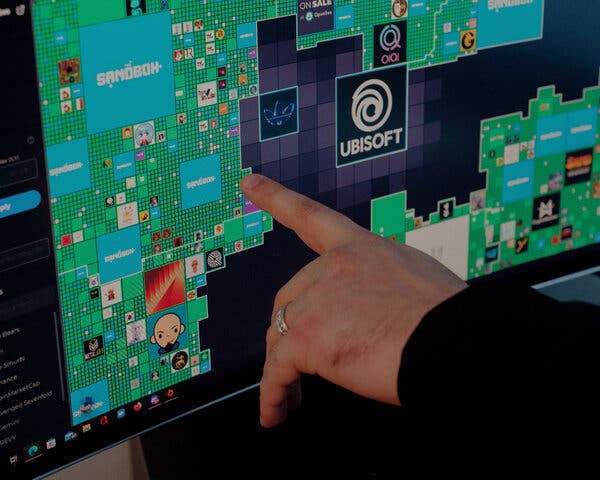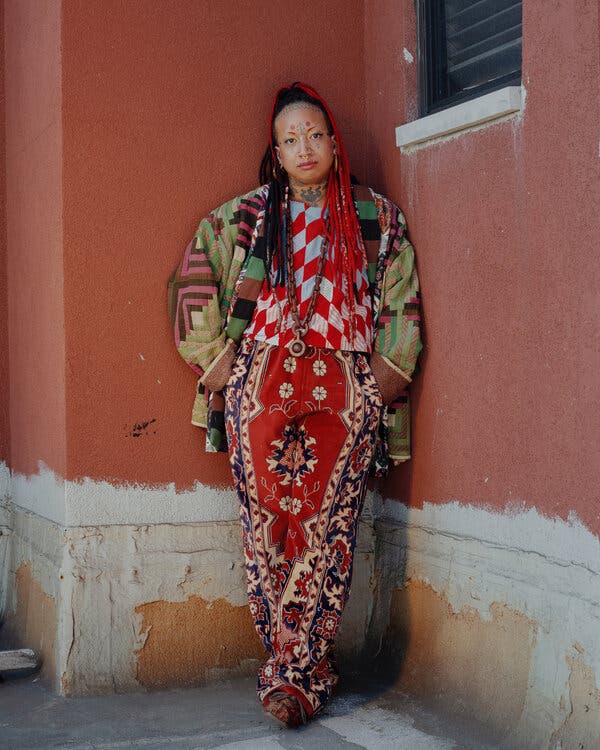More On: NFTs
Why Jim Cramer suggests purchasing bitcoin or ethereum, with one exception
Shares of Coinbase fall 11% because of a hot report on inflation
Millionaire Martin Mobarak was investigated for setting fire to a $10 million Frida Kahlo painting as an NFT stunt
Limit Break's DigiDaigaku NFT collection increases by nearly 100 percent when the company raises $200 million
Binance now has more Bitcoin than Coinbase
Some collectors and artists are becoming wealthy as a result of NFTs, but success in this high-risk market is more art than science.
Izzy Pollak decided to buy two Bored Ape NFTs late one Friday last spring, which — for those of you who are thinking, Yeah, but I still don't know what an NFT is — implies he bought unique, digital photos (in this case, of apes).
As the owner of a Bored Ape, he now has commercial rights to the digital image, which he can use as he sees fit. Many people use their NFTs as their profile photo on social networking platforms.
(If you're wondering how ownership of a digital asset can be verified, each NFT, or non-fungible token, has a unique serial number, and the transaction history of each NFT is maintained on the blockchain, allowing users to determine who the true owner is.)
Mr. Pollak, 29, purchased three more NFTs a few months later from the Bored Ape Yacht Club, a collection of 10,000 NFTs. Some of the apes are dressed in gold jackets or tunics with animal prints. Others are smoking cigars or laughing heartily.
Mr. Pollak, who works for Genies, a Los Angeles-based software start-up that creates NFTs and avatars, didn't have much spare cash at the time. "I was living with three other folks in a four-bedroom townhouse," he explained. "We all used the same bathroom. It reminded me of college."
He didn't come from a wealthy family, either. Mr. Pollak claims that during the 2008 financial crisis, when he was 16, his mother was unable to pay the mortgage, forcing him and his family to rent an apartment.
Mr. Pollak became interested in NFTs after hearing about them on Clubhouse. "I thought to myself, 'Oh my God, this is insane.'" "I'm ready to spend hundreds of dollars on a monkey picture," he explained.
It turned out to be a wise move. Mr. Pollak's apes surged in value last October, five months after he purchased his first NFTs. He sold one he had purchased for around 14 Ether (a virtual currency worth approximately $40,000 on the day of purchase) for approximately 70 Ether (approximately $231,000 on the day of selling).
He put the money toward a down payment on a three-bedroom house with a backyard in Los Angeles. "We call it the Chimp Chalet," he joked. "I'd always wanted to own a house but never imagined I'd be able to make it work."
Because of NFTs, a select few people now have their own rags-to-riches stories. Some collectors and digital artists have made "life-changing money" by investing in the appropriate project at the right moment, according to Matt Medved, founder of Nft Now, a digital media outlet promoting NFTs. Some are utilizing the income to pay off student loans, purchase a home, or leave professions they despise. (Of course, some folks buy yachts or host extravagant parties.)
"NFTs are like manna from heaven," remarked Mr. Pollak, who also recognizes his good fortune. "I've heard horrific stories about people using their rent money to buy NFTs." It's upsetting to see individuals put their money at danger when it usually doesn't work out."
The majority of people who make or acquire NFTs never make a profit. There is no regulation or consumer protection, and trading them is roughly equivalent to gambling. Investing in cryptocurrency is high risk and requires a great deal of technical knowledge and chance; few financial professionals would encourage it, and frauds abound.

Mr. Medved suggests comparing NFTs to baseball cards. "Our society has acknowledged for years that rare baseball cards have worth," he remarked. "Last year, a rare Mickey Mantle card that probably cost 5 cents to create sold for $5.2 million." And why is that? It isn't about the physical card stock. It's the history, rarity, scarcity, and cultural significance."
"It all boils down to fandom," he continued.
Similarly, many NFT artists' and collectors' investments will be worth little or nothing in the long run. However, there are a few NFTs that have grown in value and earned their owners and inventors large sums of money in a short period of time.
Mr. Pollak's Bored Apes, for example, might be coined — that is, put on the market — at.08 Ether ($200 last spring). Less than a year later, the cheapest one is worth approximately 73 Ether (almost $190,000). (Ether can be converted to cash and deposited to a bank account using major cryptocurrency services such as Coinbase and Gemini.)
Another NFT success story is Claire Silver, an artist in her early 30s who works with artificial intelligence. Someone she met on Slack gave her three CryptoPunks, a collection of 10,000 distinct pixel art figures generated by a computer, in 2017.
"I was in a bitcoin chat room, and I met this man who was interested in art," said Ms. Silver, who travels but most recently lived in Denver. "He told me he had 730 CryptoPunks and asked if I wanted three," she explained. 'Sure,' I said.
Collectors could get CryptoPunks for free in 2017 if they possessed an Etherum wallet. The lowest one is now selling for roughly 68 Ether (almost $175,000).
She hung onto hers until 2020, when she heard rumors that they were being sold for a lot of money. She sold one for around $60,000 in July 2021 and still has two others. (Many are fetching six figures.) One sold for nearly $600,000 last month.)
Ms. Silver creates her own NFTs as well. She, like all NFT artists, earns money from the first sale and may receive 10% of all subsequent sales. One of her works fetched 15 Ether ($63,000 at the time).
She has saved so much that she now feels financially comfortable, at least for the time being. "This sum of money means a lot to me because I come from a low-income family." "When I was growing up, we had to accept church handouts for food," she explained. "I walked into Walmart the other day thinking, 'I can purchase the cheese, I can get the decent coffee.'" I'd never felt such liberation before."
She recently returned from a trip to the United Kingdom, where her art was auctioned off by Sotheby's, and she has another journey scheduled to Japan.
She is even giving her mother a house this month, which she paid for entirely in cash. "I got one of those huge red bows," she explained, "and I'm going to place it on the front door like in those ads." "I've wanted to do something like this for my mom since I was a kid."
Alex Lugo, 29, of Lindenhurst, N.Y., used to drive trucks to support his wife and two children, ages 9 and 5. "I was making $25 per hour," he explained. "In New York, that's nothing." He chose to participate in a class to learn how to trade in bitcoin, which transformed the course of his family's life.
While other collectors acquire select NFTs and keep them for years, he flips a lot of them quickly. "I ended up buying them and flipping some of them for $10,000, some for $30,000, some for $5,000, and some for $2,000," he explained.
He has also benefited from his investment in more recent varieties of NFTs. "I own property in the Metaverse near the Adidas headquarters," he explained. "It's like having property in the Hamptons, because what will Adidas do when they want to expand?" They're going to buy me out and pay me millions of dollars, so I'll have to relocate."
("This sounds theoretical rather than simply provable," Mr. Medved wrote in an email.)
Mr. Lugo earned enough money from these individual transactions to be able to leave his truck driving profession in January 2021. He claims to have saved a large sum of money for his children, who would "have the flexibility to choose what they want to do with their life."
He and his family are now residing in a two-bedroom apartment, but he is hoping to purchase a four-bedroom home in Lindenhurst.
NFTs have assisted others in digging themselves out of financial ruts and resuming their lives.

She left that position in 2019 to become a tattoo artist, but even that was difficult, especially in the early months of the pandemic. "I was struggling to make ends meet," she admitted. "Unfortunately, I had a lot of debt, such as credit card debt and medical debt, because I am transgender and had surgery."
She noticed that people were going crazy about NFTs in the winter of 2021, so she decided to try to make her own collections, with work focusing on her Filipino and Black ancestry, and cooperate with other artists on their NFTs.
She has now paid off her debt and is now earning enough money from NFTs to pursue her passions alone. "I don't have the tension that I need as an artist to produce money," she explained. "I can pay the rent and not have to worry about not being able to make ends meet."
While some people are becoming wealthy as a result of NFTs, Mr. Medved cautions people to keep in mind that many other NFT ventures lose value over time. "Never invest more money than you are willing to lose," he said. "The NFT area, like the crypto world, is quite volatile, with markets that move swiftly up and down."
"I believe a lot of NFTs will wind up dropping to zero in the long term," he said. "Your success is dependent on your ability to select the best tasks, which is not simple."
** Information on these pages contains forward-looking statements that involve risks and uncertainties. Markets and instruments profiled on this page are for informational purposes only and should not in any way come across as a recommendation to buy or sell in these assets. You should do your own thorough research before making any investment decisions. All risks, losses and costs associated with investing, including total loss of principal, are your responsibility. The views and opinions expressed in this article are those of the authors and do not necessarily reflect the official policy or position of USA GAG nor its advertisers. The author will not be held responsible for information that is found at the end of links posted on this page.

















